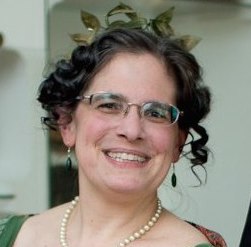For no reason other than habit, June is always foxtrot month for me, and despite the general shutdown of dance classes, I’m lucky enough to have a convenient partner at hand for experimentation with new variations. So let’s look at yet another of the many step-sequences described in Edna Stuart Lee’s Thirty Fox Trot Steps (New York, 1916)!
The Pavlowa Extension was, of course, named for the famous ballerina Anna Pavlowa (Pavlova), who toured America in the mid-1910s and dipped into social dance choreography with a music-composition contest resulting in a trio of dances published in The Ladies’ Home Journal in early 1915. She (or her ghostwriter) and (supposedly) members of her troupe also offered opinions and suggestions about dancing the one-step, Boston, and foxtrot. This variation, however, is not among those even indirectly associated with Pavlova. It probably was merely named in her honor, or perhaps was inspired by a characteristic movement in her dancing.
Lee described this as “an easy step, and very graceful, savoring a little of the stage.” She also connected it to the hesitation waltz which involved a similar slight lift while hesitating: “The hesitation, while it lasted, was full of such steps and they were much appreciated.” The half-and-half was another dance that used a similar technique to fill time.
The variation is done in a normal closed ballroom hold, facing line of dance. The gentleman’s steps are given below; the lady dances opposite except as noted.
The Pavlowa Extension
1234 four walking steps forward, starting with the left
1 slide left foot forward
2 rock back onto right foot, drawing left foot to a raised position close by the right foot, toe pointed down, rising slightly
(the lady does not raise her right foot; she just rises slightly on the toe of her left foot)
3&4 two-step forward starting on the left foot
123&4 repeat leading with the right foot
1234 four walking steps forward, starting left foot
1&2 two-step half-turn clockwise
1234 four walking steps backward, starting right foot
1-8 step-rock/two-step sequence as above, except that the lady raises her foot and rises on the right while the gentleman merely rises slightly on the toe
1234 four walking steps backward, starting right foot
1&2 two-step half-turn clockwise to face line of dance
Reconstruction/Performance Notes
(1) Yes, the sequence really is counted 4-4-4-4-2, 4-4-4-4-2. Yes, you may feel weirdly off the musical phrase after that first two-step with no matching movement. Yes, an eighteen-bar sequence is a bit weird, but that’s how she wrote it. If it bothers you intensely, do only two walking steps before the single two-step instead of four, which preserves the feel of the sequence without the weirdness.
(2) Lee stated that when the gentlemen extended the foot, the lady should rise on the toe of the opposite foot. It’s feasible to do this the first time through as a slight lift of the lady with the gentleman remaining flat on the floor, but (1) it doesn’t feel graceful, and (2) it’s absolutely dreadful on the repeat, when the lady is doing the raised foot and the gentleman rising. Given a ballroom hold, having the gentleman rise and the lady not is difficult to lead; the lady feels the gentleman’s rising movement and naturally joins it unless he consciously isolates his arms and shoulders to prevent it. I was able to make this work from the gentleman’s role, albeit with rather more concentration than I want to apply when dancing foxtrot, but my practice partner, dancing the lady’s role, found the necessary breaking of connection absolutely horrifying and forbade me to ever repeat it. Note to gentlemen: do not do things that cause a lady to make unhappy faces while dancing.
(3) When leading this sequence initially with a partner who does not know it, the lady will naturally tend to leave her right foot extended behind her while the gentlemen is raising his and pointing his toe downward. Unless she knows the variation, however, she will not do that raising of foot and pointing of toe when it’s her turn. This doesn’t actually matter; the lift will feel nice regardless. But if the gentleman would like to cue the lady that there is something to be done with the free foot, he should look at his foot each time he does the raise-and-point. This will cause her to also look, to find out what he’s looking at, and with luck enable her to copy the movement when it’s her turn. I realize this sounds silly, but it works — a reasonably skilled lady can and will follow his gaze just like she follows any other movement in dance.
A final note: while I am no expert on Pavlova and whether she was particularly known for little lifting motions like this, I do find this sequence to be something like a very gentle version of the “lifting” step in the maxixe, as shown by Vernon and Irene Castle in The Whirl of Life. The step can be seen here, but be certain to turn the volume on the video all the way down to avoid the wildly inappropriate music. Note that this is a loose similarity of movement only; the Pavlowa Extension is considerably less vigorous!
Special thanks to Irene for partnering my foxtrot experiments and for the priceless appalled expression!


Leave a Reply